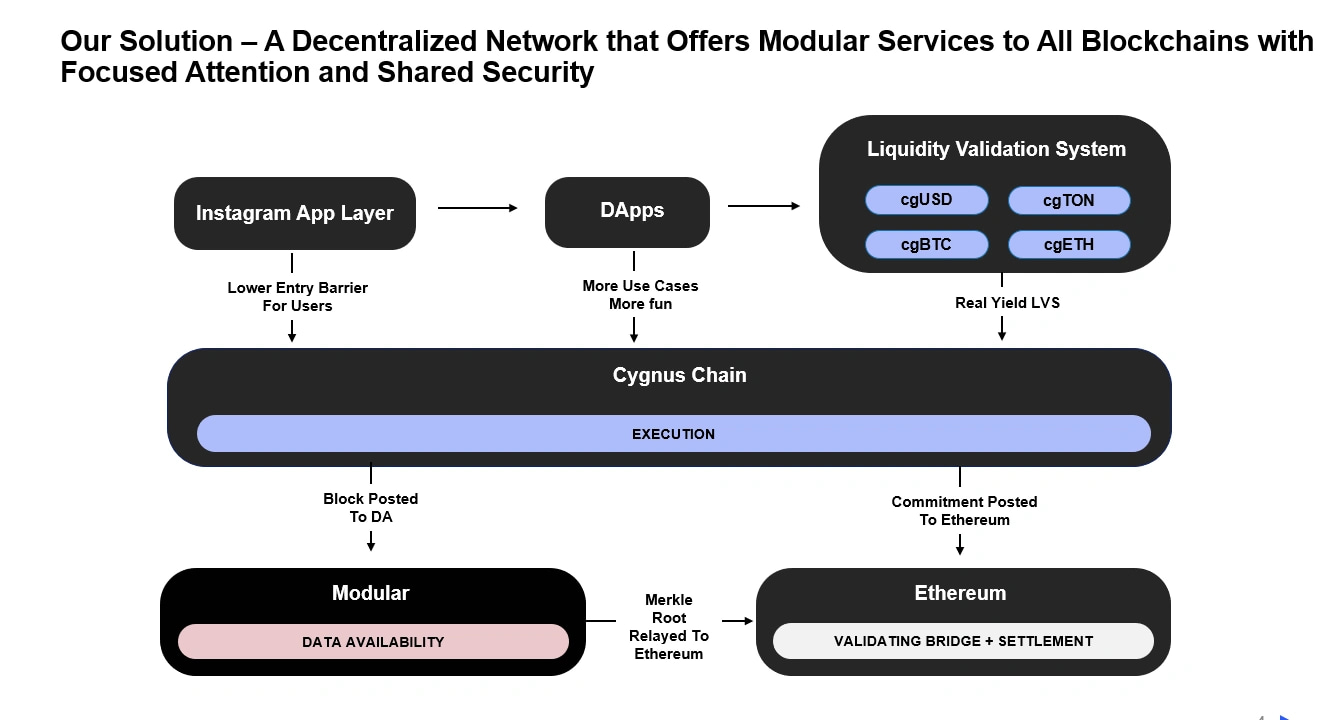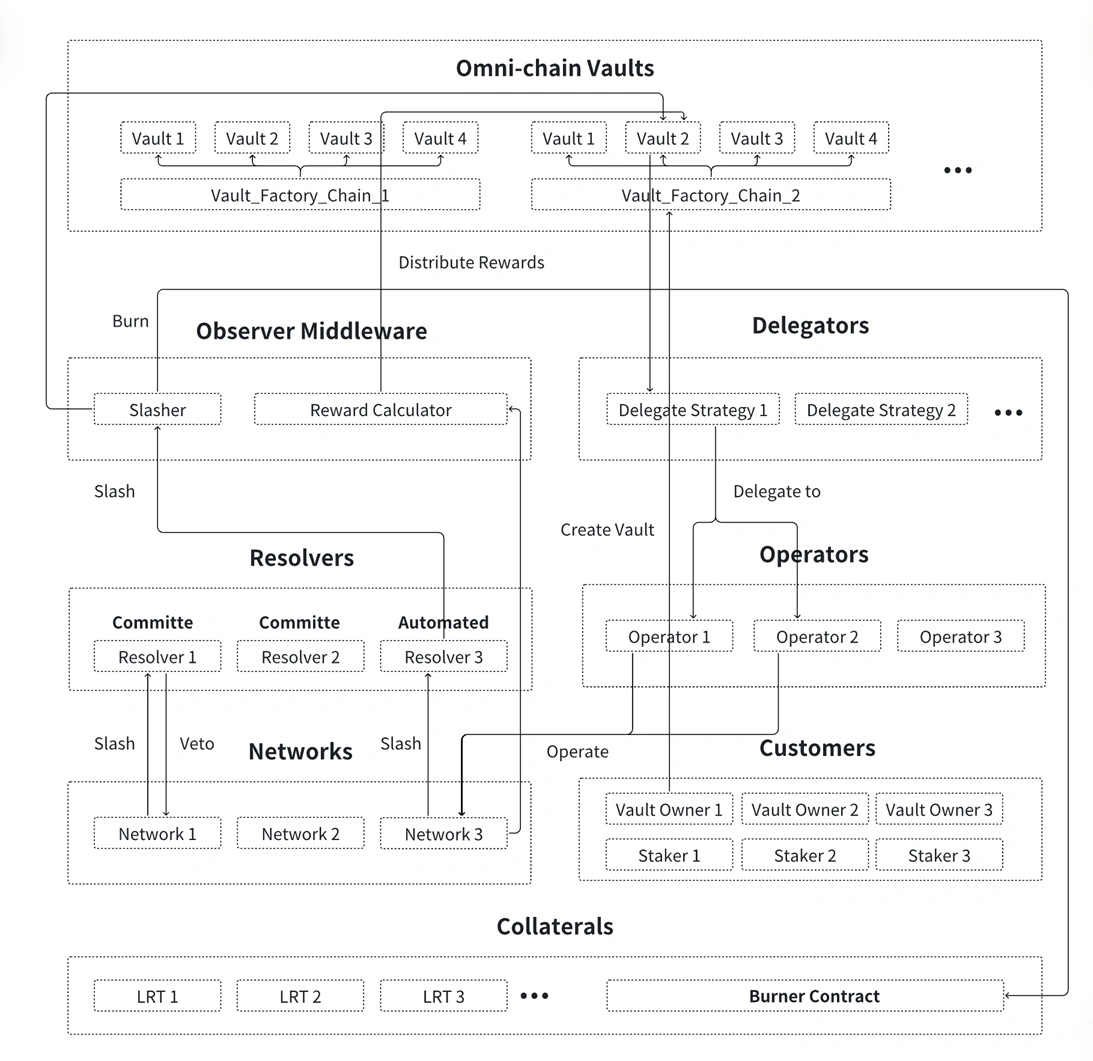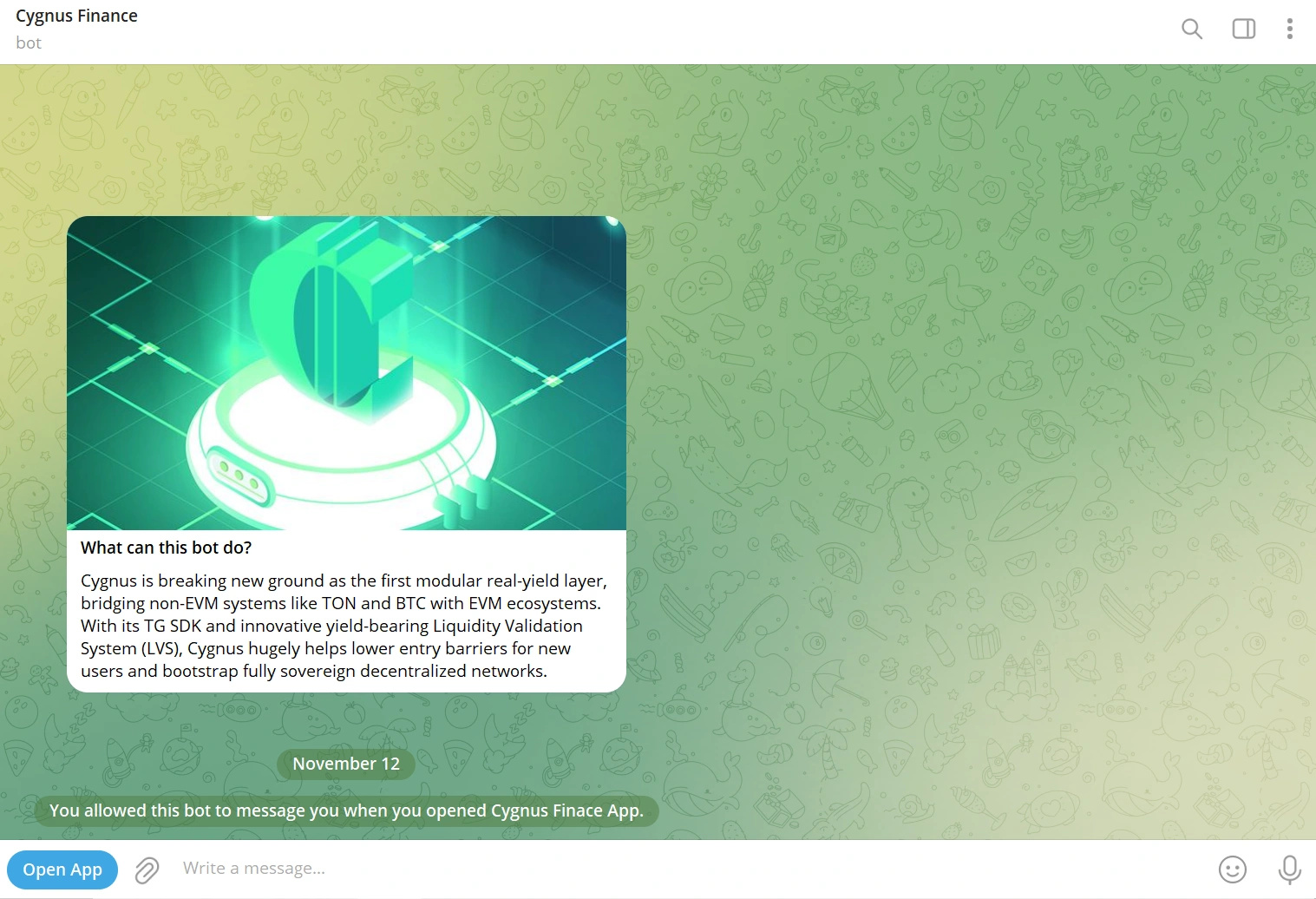Read
Edit
History
Notify
Share
Cygnus Finance
Cygnus Finance is a decentralized platform integrating Web3 capabilities with traditional financial systems, enabling seamless user interaction and transaction management. It leverages modular infrastructure to provide scalable, secure, and sustainable solutions for the growing blockchain ecosystem. [1]
Overview
Cygnus is a modular yield-focused protocol that functions as a Web3 application layer for Instagram. It aims to integrate on-chain and off-chain assets to support the creator economy. The Cygnus Omnichain Liquidity Validation System (LVS) is used to validate liquidity and staking infrastructure across EVM and non-EVM networks. This system enables staking returns, fee generation, and ecosystem incentives.
The Cygnus Instagram App Layer links with a large Instagram user base, offering access to Web3 tools and decentralized applications. It also supports data ownership initiatives and future AI features. Features like Account Abstraction wallets simplify onboarding for users and creators.
Cygnus combines an application layer with supporting infrastructure to offer a scalable framework for Web3 adoption and decentralized participation. [9]

Technology
Cygnus LVS
Cygnus LVS is a decentralized coordination layer that allows network developers to independently configure and manage their staking or restaking systems without requiring permission. Its structure supports open participation and flexible implementation across various blockchain ecosystems.
The protocol offers modular control, giving developers full authority over their staking processes. This includes defining accepted collateral, selecting node operators, structuring rewards, managing slashing protocols, and setting up resolution mechanisms. Participants can engage with or exit shared security frameworks at their discretion.
Cygnus prioritizes capital efficiency through a permissionless, multi-asset, and network-agnostic model that facilitates scalable access to economic security. An evolving reputation system for operators across networks is intended to improve developers' efficient use of capital.
To minimize risk, Cygnus deploys non-upgradeable core contracts on Ethereum and TON, which removes reliance on external governance and avoids centralized points of failure. The contract design focuses on simplicity and adaptability to maintain security at the execution layer. [2]

Architecture
The architecture is built around five interconnected components. Collaterals act as the base layer of security, abstracting various on-chain assets without restriction to specific blockchains. Vaults manage the delegation of these assets to operators and can be customized by restaking platforms or institutional participants. Operators are responsible for managing network infrastructure and receive support through vault allocations. Resolvers oversee and decide on slashing actions, functioning as automated systems or independent bodies that enforce penalties. Cygnus networks can design and control how they integrate operators and collateral, tailoring onboarding, incentives, and enforcement according to their specific needs. [2]
Collateralization
Cygnus LVS uses a collateral framework that allows assets to remain productive outside its protocol while contributing to network security. Assets used as collateral can stay deployed in DeFi strategies or staked in other networks, promoting capital efficiency without being locked within Cygnus.
Cygnus applies enforcement mechanisms to manage risk, enabling slashing penalties when participants violate network rules. These mechanisms operate through control contracts rather than direct custody of the assets, allowing penalties to be executed through predefined on-chain actions.
Collateral positions are represented by Omni-Chain Collateral Tokens (OCTs), which standardize collateral use across multiple blockchains. These tokens carry embedded governance features and logic to support staking, validation, and risk control.
Slashing functions are adapted to different asset types. For liquid staking derivatives, enforcement may involve triggering withdrawals or burns via smart contracts. For governance tokens, slashing usually sends the penalized amount to non-recoverable addresses. To maintain compliance, tokenized real-world assets rely on a combination of off-chain oracles and on-chain enforcement.
The system supports several collateral types, including liquid staking tokens, governance tokens, and tokenized real-world assets. Overall, Cygnus’s approach separates asset custody from security enforcement, allowing for more flexible and efficient capital use while maintaining network safeguards through smart contract-based slashing mechanisms. [3]
Vault Delegation
In Cygnus LVS, vaults form the central structure for managing the delegation and restaking of collateral. These vaults handle accounting for deposits, withdrawals, and slashing, while also managing how collateral is allocated to operators across networks. They are responsible for distributing rewards to participants based on their active contributions, with networks required to opt into any defined delegation strategies.
Vaults come in various forms, including operator-specific vaults designed for restaking with individual operators, curated multi-operator vaults offering customized configurations and slashing limits, and immutable vaults with fixed, non-editable rules for added security. Supporting modules ensure smooth operations: the slasher module verifies slashing events and operator eligibility, while the delegator module enforces limits on stake distribution across operators and networks.
The system follows an epoch-based structure, where deposits are activated immediately, and withdrawals are processed over multiple periods. Slashing can occur instantly or after a veto phase, with penalties shared proportionally among users. Delegation logic distinguishes between restaking across networks and preventing restaking within the same network. Rewards for both stakers and operators are distributed based on their participation levels and managed through the vault’s internal systems. [4]
Network Coordination
In Cygnus, a network refers to any protocol requiring decentralized infrastructure to support crypto-related services such as application hosting, data delivery, or cross-network operations. These networks use Cygnus to source security by selecting operators and staking collateral according to specific needs. The modular framework allows networks to define operational rules, including support for multiple sub-networks with distinct roles.
Each network is defined by a unique address on Ethereum or TON and operates through a middleware contract responsible for custom logic, including slashing enforcement and reward distribution. The system runs on epochs, where each period aligns with the vault's governance phases to ensure the integrity of the captured stake. Stake allocation is controlled through modules that limit how much can be staked per operator and network.
Operators and networks register through designated functions, and stakers deposit funds into vaults. If operators violate rules while opted into the vault and network, slashing is enforced, with penalties calculated and triggered by the slasher module. Rewards are distributed to stakers and operators according to network-specific logic, including off-chain or on-chain processes. The Cygnus framework supports secure and adaptable coordination for a wide range of decentralized network services. [10]
Dispute Resolution
Cygnus implements a Dispute Resolution Framework to oversee and manage slashing events related to operator misconduct or protocol violations. Instead of relying entirely on automated enforcement, the system incorporates Independent Resolution Entities (IREs), including smart contracts, external committees, or decentralized arbitration protocols, to assess and validate slashing proposals. These entities can approve, reject, or request further evidence before penalties are enforced.
The framework allows for flexible configuration of collateral exposure to slashing risk. Vaults and operators can allocate portions of their stake to be managed by different oversight mechanisms. For instance, some collateral may be subject to immediate automated slashing, while others may require approval from designated IREs. This enables tailored risk management depending on the vault’s strategy and the network’s needs.
Cygnus also integrates with decentralized arbitration platforms like Kleros, UMA, and Reality.eth to provide neutral dispute adjudication. Multi-signature and quorum models further enhance this system by requiring consensus among multiple entities before finalizing any slashing decision. This structure promotes fairness, decentralization, and accountability while reducing the risk of unilateral enforcement. [5]
LVS Integration
- cgETH is a liquid staking token that allows users to stake smaller amounts of ETH without requiring technical expertise or expensive hardware. It provides liquidity by enabling users to trade, transfer, or deploy staked assets in other DeFi protocols. It also allows participation in blockchain validation rewards and additional returns through yield farming and liquidity mining activities. [11]
- clBTC is a token designed to connect Bitcoin with decentralized finance (DeFi) yield opportunities, offering enhanced capital efficiency and flexibility. It addresses challenges Bitcoin holders face, such as liquidity constraints and limited yield-generation options, by enabling Bitcoin liquidity staking and combining centralized and decentralized finance features for participation in DeFi mining, liquidity provision, and governance. [12]
- cgUSD is an interest-bearing stablecoin minted by Cygnus Finance, collateralized by short-term U.S. Treasury bills. It shares the interest income from U.S. Treasuries with users through a rebase mechanism, ensuring its balance increases as the net asset value rises. On each New York banking day, cgUSD’s total supply is adjusted to align with the value of its asset portfolio, which includes U.S. Treasuries, on-chain stablecoins, and asset interest, guaranteeing a 1:1 redemption ratio with USDC. Cygnus Finance also offers the option to wrap cgUSD into wcgUSD, which maintains value consistency and provides interest distribution for holders. [13]
Social App SDK
Instagram App Layer
Cygnus has developed an Instagram App Layer that integrates blockchain functionality directly into the social platform. This infrastructure enables using both on-chain and off-chain assets within Instagram, allowing developers to create modular Web3 features such as token rewards, NFTs, and asset management tools. The aim is to simplify user onboarding and lower technical barriers, offering a more accessible way for users to interact with blockchain technology through a familiar social media interface.
Through its status as a verified technology provider by Meta, Cygnus can embed Web3 tools natively into Instagram. This includes a wallet system powered by Account Abstraction (AA) that allows users to interact with Web3 without needing seed phrases, private keys, or separate wallet apps. Instagram login credentials automatically generate a Web3 wallet linked to the user’s social identity, streamlining access while offering standard features like password recovery and secure key management. [14] [15]
Telegram Mini App
CygnusFinance Bot is a tool designed to simplify global transactions and integrate seamlessly with Web2 users. It aims to lower barriers to entry, making financial services more accessible to a broader audience. The bot is more than just a communication tool; it is a gateway to a more inclusive financial ecosystem.
CygnusFinance Bot allows users to easily conduct transactions, benefiting from streamlined payment processes and enhanced access to financial tools. The bot is positioned to support mass adoption by making it easier for individuals to engage in financial activities, even within a global context. [6]

Cygnus Token
$CYGNUS is the native token of the Cygnus Network, which is essential for securing and powering its modular yield infrastructure. It is used for staking in the Liquidity Validation System (LVS), where it provides liquidity, earns rewards, and secures emerging blockchains. $CYGNUS also functions as a reward and incentive token within the Cygnus Instagram Layer, compensating users and creators for engagement and content creation. As the gas token for transactions on the network, it covers sequencer fees, gas fees for dApps, and data publication fees. Additionally, $CYGNUS enables governance, allowing token holders to vote on protocol upgrades, fund allocations, and economic parameters, ensuring community-led growth and sustainability. [7]
Partnerships
- Wormhole
- Phylax
- BitFi
- HashKey Cloud
- GAIB
- RedStone Oracles
- Hemi
- Lorenzo
- Chainlink
- OKX Ventures
- Coinbase
- Base
- G-2 Group
- Mirana
- GSR
- The Open Network Foundation
- Optimism Foundation
- Manifold
Cygnus Finance
Feedback
Did you find this article interesting?
Twitter Timeline
Loading
Related Articles

Mantle Restaked Ether (cmETH)
cmETH is a value-accruing receipt token for mETH restaking, offer...

TN Vault
TN Vault is a multichain lending protocol enabling users to borro...

Mantle Network
Mantle Network is a Layer-2 scaling solution for Ethereum, using ...

Kinesis Money
Kinesis Money is a decentralized, asset-backed monetary system de...
Media
REFERENCES
[1]
[2]
[3]
[4]
[5]
[6]
[7]
[8]
[9]
[10]
[11]
[12]
[13]
[14]
[15]


